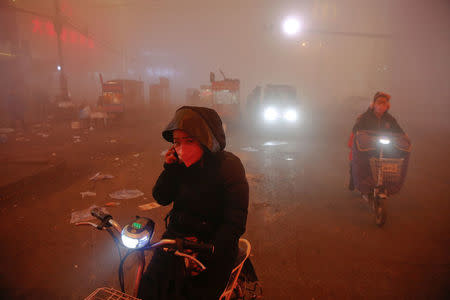China's Hebei vows coal curbs ahead of winter smog war

SHANGHAI (Reuters) - Hebei, China's smoggiest province, on Friday said it would ensure it meets its targets to replace coal with natural gas, while accelerating efforts to achieve politically crucial 2017 air quality targets. The local government said on its official website on Friday that it would ensure as many as 1.8 million households completed the switch to gas from coal for fuel and heating by the end of next month, despite concerns in the province that the transition was proving too costly and difficult. The step is part of efforts to cut annual provincial coal consumption by more than 6 million tonnes. Hebei, which surrounds the capital Beijing, is on the frontline of a "war on pollution" launched in 2014. It plans to wage an "iron-fisted" campaign against smog this winter, provincial governor Xu Qin said this week. As part of a central government push to fight smog this winter, Hebei plans to reduce small breathable smog particles known as PM2.5 by 15 percent from October 2017 to March 2018, but some major cities will be forced to make even deeper cuts. Tangshan, China's top steel producing city, is under pressure to slash PM2.5 averages by more than 22 percent over the six months. It has promised to shut down polluting sectors like ceramics, cement and brickmaking once China's winter heating systems are switched on in November. Tangshan produces 90 million tonnes of crude steel annually, and is also under orders to cut production of the alloy by half once heating begins. Hebei will also impose emergency restrictions on big polluters and curb the production and transportation of raw materials during smog build-ups, Yin Guangping, vice-head of the Hebei Environmental Protection Bureau, said Thursday. Inspectors have been visiting sites across the region to ensure that small "scattered" sources of pollution are "rectified". They have also been cracking down on "false reporting" by enterprises pretending to comply with tough new standards. The Beijing-Tianjin-Hebei region has been struggling to cut 2012 levels of PM2.5 by 25 percent this year. Average concentrations in the first eight months of 2017 stood at 66 micrograms, still 11.9 percent higher than a year earlier, the China Daily reported on Friday, largely because of near record smog in January and February. Huang Wei, climate and energy campaigner with Greenpeace in Beijing, said there was still "a long way to go" before the targets are met. "The Ministry of Environmental Protection's job has been made much harder over the last year by economic policies that have favoured the most polluting economic sectors, particularly the steel industry," she said. (Reporting by David Stanway; Editing by Joseph Radford)

